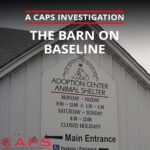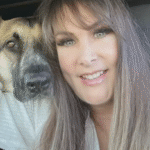Breeder: Miller , Samuel
Business name: Miller Kennels
Address: 5789 Candon Ave.
City, State Zip: Kalona, IA 52247
Year: 2004
USDA License: 42-A-0897
USDA Inspector: Ron Beard, ACI
Date of CAPS Investigation: 2004-09-30
Approximately 31 dogs and 12 puppies. Breeds: Miniature Pinchers, Boxers, Airedale Terriers, Yorkshire Terriers
Note: Miller has moved from his old address of 5759 James Ave. to the new address listed above. The old property is owned by new Amish residents.
Miller’s kennel consisted of several series of pens west of Miller’s house.
Building with indoor/outdoor cages
The kennel building was a wooden structure about 10 feet wide and 15 feet long with a single door on one of the short sides of the building. There were eight indoor/outdoor cages on each long side of the building. Each group of cages consisted of a row of four cages on the bottom, raised about 1.5 above the ground, and a row of four cages about a foot above them. Each cage was about 1.5 feet wide, two feet long, and 1.5 feet high. Several of the pens held two adult Airedale Terriers, while several others contained two adult Yorkshire Terriers. One pen contained a boxer puppy about 8 weeks old, and two other pens contained nursing Yorkshire Terrier mothers with several puppies about two to three weeks old.
The cages had plastic roofing and backs with doggie doors leading to inside cages. The other three walls were made of untreated, thin-gauge wire (3.6(a)(2)(xii)-Primary enclosures). Flooring was made of treated wire. Cage floorings and the three wire walls were enclosed by untreated, rusting thick-gauge wire on its outside (3.1(c)(1)(i)-Surfaces).
The cages had metal beams running through them and at their corners for support. There was wooden shelving about three inches below each set of cages to catch feces and debris. Several weeks’ accumulation of mostly-dried feces was under each cage (3.11(a)-Cleaning of primary enclosures). The plastic backing of many pens had feces stains on them (3.11(a)(1)-Cleaning of primary enclosures).
Cages inside the structure had plastic walls, flooring, and roofing. These cages had doors made of rusting, thin-gauge wire covered with rusting thick-gauge wire (3.1(c)(1)(i)-Surfaces) (3.6(a)(2)(xii)-Primary enclosures).
Some of the pens had pieces of carpet laid down on the flooring, and all of the cages contained a lix-it watering system. The walls exhibited oil and feces buildup, and the floorings were covered in so much feces accumulation that the dogs could not lie down without being in contact with the excrement (3.11(a)(1)-Cleaning of primary enclosures).
Most of the cages had plastic or metal self-feeders about ten inches tall and filled to within two inches of the top with food, containing more than a day’s worth of food for the dogs in these pens (3.9(a)-Feeding). Dirty buildup was evident on all of the self-feeders (3.11(a)(1)-Cleaning of primary enclosures).
Two pens with Airedale Terriers contained empty plastic food dishes (3.9(a)-Feeding). The food containers were not placed so as to minimize contamination by excreta (3.9(b)-Feeding). The cages containing nursing Yorkshire Terrier mothers and puppies had plastic cat litter trays filled with shredded paper in them. There were plastic food dishes containing puppy food set on the cage flooring in a manner that did not minimize contamination by excreta (3.9(b)-Feeding).
The plastic flooring of the room was covered with dirt and pieces of dog food (3.11(a)-Cleaning of primary enclosures.)
Outdoor pens with doghouses
North of the kennel building were five pens, each about 15 feet wide and 15 feet long, with thick-gauge wire walls about five feet high surrounding each pen. The pen on the western end of the row was only 10 feet wide. Four pens each contained two to three adult Boxers, while the western pen contained two Clumber Spaniels.
Each pen had a thick layer of small pebbles on the ground for flooring and a wooden dog house about eight feet wide, five feet long, and five feet high with a plastic windbreak at its entrance. The corner of each pen had a wooden board about five feet wide and five feet. Each pen also had a metal self-feeder attached to one their wire walls. Each pen had more than 24 hours’ accumulation of feces in it (3.11(a)-Cleaning of primary enclosures). One of the Clumber Spaniels had a bloody sore about two inches in diameter in the middle of its left side (2.40-Vet Care).
Second building
Another building about 10 feet wide and 15 feet long had a single door accessing its southern side and windows on its east and west walls. Along the east and west walls inside the building were bench-like protrusions about 1.5 feet above the plastic flooring. Along each bench was plastic piping connecting to four lix-it style watering devices about eight inches above the floor.
The floor was covered in sawdust, dried feces, plastic self-feeders, and a shattered plastic tub about twice the size of a cat litter box (3.11(a)-Cleaning of primary enclosures). The benches supporting the water system, and the plastic piping of the watering system, were covered in dried feces was (3.11(a)-Cleaning of primary enclosures). The excrement appeared to be from small dogs; however, no animals were in the building at the time.
Boxer pens
East of the second building were three sets of enclosures each containing two dog pens Each pen was about four feet wide, seven feet long, and four feet high. A wooden substructure raised each pen about a foot above the ground. These pens had sheets of metal for roofing and thinner, treated wire for flooring. There were two adult Boxers in each pen.
Each pen contained a wooden box about four feet wide, four feet long, and four feet high with a plastic windbreak over the entrance. . The pens were made of thick-gauge wire with rusty metal beams supporting the corners (3.1(c)(1)(i)-Surfaces).
Each pen had two plastic or metal self-feeders attached to the wire walls. All of the feeders were empty. The top half of one plastic self-feeder was broken away, leaving jagged edges of plastic protruding. This feeder was attached to the outside of the pen; however, the Boxers inside could reach the broken plastic through the wire with their paws. There appeared to be more than a week’s accumulation of feces and dozens of flies under each pen (3.11(a)-Cleaning) (3.11(d)-Pest Control).
Boxer puppy pens
At the southeastern edge of the kennel property were two pens with walls made of thick-gauge rusting mesh wire. Each pen contained four to five Boxer puppies about six to eight weeks old (3.1(c)(1)(i)- Surfaces).
These pens also exhibited more than a week’s accumulation of feces and dozens of flies under them. The piles of feces were a foot high, and the wooden beams supporting the pens were splattered with feces (3.11(a)-Cleaning of primary enclosures) (3.11(d)-Pest control).
Download attachments:MillerIA-1.pdf
MillerIA-2.pdf
MillerIA-3.pdf
MillerIA-4.pdf
MillerIA-5.pdf
MillerIA-6.pdf
MillerIA-7.pdf
MillerIA-8.pdf




